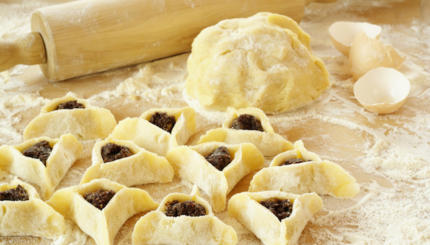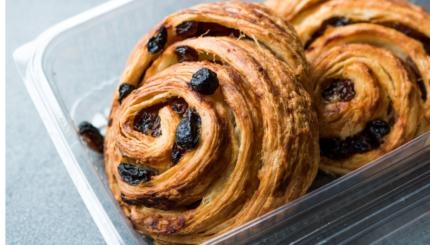Nut Pastries
Nut-filled pastries
Reprinted with permission from Sephardic Flavors: Jewish Cooking of the Mediterranean (Chronicle Books).
Every Sephardic cookbook and probably every Sephardic cook has a version of these nut-filled cookie-like pastries. The Turks prefer walnuts for the filling, but the Greeks lean toward almonds. I prefer the filling that uses currants along with the nuts, as I love their chewy texture after the pastry is baked. In Rhodes, travados were traditionally served at Purim, while in Turkey they were on the table at Rosh Hashanah to celebrate the sweet new year, and a variation called borekas de muez was served at Purim.
The pastries are sometimes dipped in syrup, although the Greeks use a sweeter outer pastry and omit the syrup, instead just sprinkling the baked pastries with confectioners' sugar while they are still warm. If you are nor going to use the syrup, increase the sugar in the dough, although in this case I think the syrup adds a delicate texture to the dough. Travados store well in a tightly closed tin or plastic container for up to a week.
Ingredients
1 teaspoon cinnamon
2-3 Tablespoons water
3 Tablespoons cognac
1/2 cup dried currants
1 1/2 cups ground blanched almond
1 cup confectioners' sugar
1 egg yolk, diluted with a bit of water, for glaze
1 egg white, for sealing dough (optional)
1/2 teaspoon almond extract
3/4 cup sweet wine such as late harvest riesling or marsala
1/2 cup unsalted butter, melted and cooled
2 Tablespoons granulated sugar
1 cup confectioners' sugar
3 cups all purpose flour
2 cups ground blanched almonds
2 cups confectioners' sugar
1/4 cup fresh orange juice
3 Tablespoons grated orange zest
Directions
To make the pastry, in a bowl, stir together the flour and sugar. Slowly add the butter, wine, and almond extract, stirring until a smooth, soft dough forms. Let rest in the bowl for 15 to 20 minutes.
Meanwhile, preheat the oven to 350 degrees F. Lightly butter two baking sheets with sides or line them with parchment paper. Select one of the fillings, place the ingredients for it in a bowl, and stir to mix.
Pull off a walnut-sized piece of the dough and roll it into a ball between your palms. Flatten the ball and place it on a lightly floured work surface. Roll it our into a three-inch round about 1/8-inch thick. Moisten a fingertip with egg white or water and dampen the edge of the round. Place two teaspoons of the filling in the center of the round and fold the round in half to form a half-moon. Pinch the edges of the dough together. Place on a prepared baking sheet. Repeat until all the dough and filling arc used. Brush the half-moons with the egg-yolk glaze.
Bake the pastries until lightly browned, 20 to 25 minutes. Remove from the oven and let cool on the baking sheets on a rack.
If you are using the syrup, prepare it while the pastries are baking: In a saucepan, combine the water, sugar, lemon juice, and the orange zest, if using, and bring to a boil over medium heat, stirring until the sugar dissolves. Boil until the syrup coats a spoon, about 10 minutes, then remove from the heat. Add the orange-flower or rose water, if using, and remove from the heat. Let stand for a few minutes, then dip the cooled pastries in the warm syrup and place on racks to drain for a few hours.
If you are not using the syrup, sprinkle the pastries with confectioners' sugar while they are still warm.
Rosh Hashanah
Pronounced: roshe hah-SHAH-nah, also roshe ha-shah-NAH, Origin: Hebrew, the Jewish new year.
Sephardic
Pronounced: seh-FAR-dik, Origin: Hebrew, describing Jews descending from the Jews of Spain.


